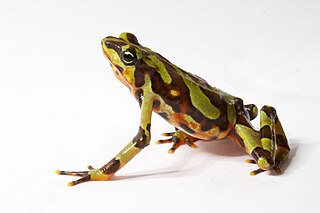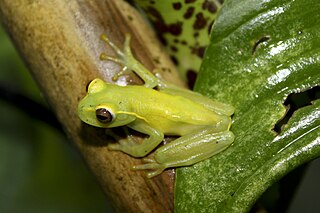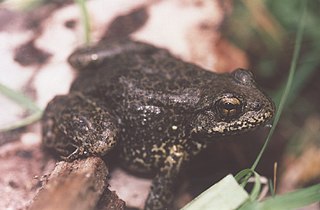
Since the 1980s, decreases in amphibian populations, including population decline and localized mass extinctions, have been observed in locations all over the world. This type of biodiversity loss is known as one of the most critical threats to global biodiversity. The possible causes include habitat destruction and modification, diseases, exploitation, pollution, pesticide use, introduced species, and ultraviolet-B radiation (UV-B). However, many of the causes of amphibian declines are still poorly understood, and the topic is currently a subject of ongoing research.

The Baw Baw frog is a critically endangered species of Australian frog as categorised on the IUCN Red List and listed under the Flora and Fauna Guarantee Act (1988), endemic to Baw Baw National Park. It has suffered a decline in population, mostly due to infection caused by chytrid fungus. Zoos Victoria has undertaken a breeding program to ensure survival of the species which commenced in 2010, and in October 2018 successfully collected the first eggs laid in captivity.

The mountain yellow-legged frog, also known as the southern mountain yellow-legged frog, is a species of true frog endemic to California in the United States. It occurs in the San Jacinto Mountains, San Bernardino Mountains, and San Gabriel Mountains in Southern California and the Southern Sierra Nevada. It is a federally listed endangered species, separated into two distinct population segments (DPS): a northern DPS, listed endangered in 2014, and a southern DPS that was listed endangered in 2002.

The Wyoming toad, also known commonly as Baxter's toad, is a species of toad in the family Bufonidae. The Wyoming toad is an extremely rare amphibian that exists only in captivity and within Mortenson Lake National Wildlife Refuge in Wyoming in the United States. The Wyoming toad was listed as an endangered species in 1984, and listed as extinct in the wild since 1991. As with black-footed ferrets at the Tom Thorne and Beth Williams Wildlife Research Center at Sybille in Wheatland, Wyoming, the effort to save the Wyoming toad has been a cooperative effort among state and federal agencies and private landowners. The Wyoming toad was common from the 1950s through the early 1970s, but its distribution was limited to the Laramie Basin in Albany County. The population crashed around 1975 and was extremely low by 1980. The Wyoming toad was federally listed as endangered in January 1984. To prevent extinction, a captive-breeding program began in 1989 at the Thorne Williams Unit that produced enough offspring in its first few years to supply seven zoos, and in 1998 the Saratoga National Fish Hatchery received captive-breeding stock. Nearly 46,000 offspring were produced at the Thorne Williams Unit from 1995 until 2006, when the remaining captive stock was moved to the Red Buttes Environmental Biology Laboratory south of Laramie, and then released back into the wild. Before the sharp declines occurred, this toad had been originally classified as Bufo hemiophrys baxteri, a subspecies of the Canadian toad, by Kenneth Raymond Porter in 1968.

Incilius fastidiosus, or the Pico Blanco toad, is a species of toad from western Panama and southeastern Costa Rica. It inhabits premontane and lower montane rainforest. It is largely a fossorial species that breeds explosively in temporary pools after heavy rains in late April–May. Juveniles occur on rocky stream margins the year round.

The boreal toad is the nominate subspecies of the western toad. They are commonly found in the western U.S. and western Canada. Boreal toad populations have declined recently due to an emerging amphibian disease, chytrid fungus. The boreal toad is currently listed as an endangered species by Colorado and New Mexico. It is known in Colorado as the only alpine species of toad.

The Panamanian golden frog, also known as Cerro Campana stubfoot toad and other names, is a species of toad endemic to Panama. Panamanian golden frogs inhabit the streams along the mountainous slopes of the Cordilleran cloud forests of west-central Panama. While the IUCN lists it as Critically Endangered, it may in fact have been extinct in the wild since 2007. Individuals have been collected for breeding in captivity in a bid to preserve the species. The alternative common name, Zetek's golden frog, and the epithet zeteki both commemorate the entomologist James Zetek.

Atelopus varius, the Costa Rican variable harlequin toad or clown frog, is a small Neotropical true toad from the family Bufonidae. Once ranging from Costa Rica to Panama, A. varius is now listed as critically endangered and has been reduced to a single remnant population near Quepos, Costa Rica, and has only relict populations in western Panama. Recent variation in air temperature, precipitation, stream flow patterns, and the subsequent spread of a pathogenic chytrid fungus linked to global climate change have been the leading cause of decline for A. varius. A. zeteki has been considered a subspecies of A. varius, but is now generally considered a separate species.

The starry night harlequin toad is a species of toad in the family Bufonidae endemic to the Sierra Nevada de Santa Marta, Colombia. Its natural habitats are sub-Andean and Andean forests, sub-páramo and páramo at 2,000–3,500 m (6,600–11,500 ft) above sea level. It is named after its unique coloration, being largely black with white spots.

Atelopus limosus, the limosa harlequin frog is an endangered species of toad in the family Bufonidae endemic to Panama. Its natural habitats are stream banks in tropical moist lowland forests and rivers of the Chagres watershed in central Panama.

The evergreen toad is a species of toad in the family Bufonidae.

Incilius melanochlorus, formerly Bufo melanochlorus, is a mid-sized species of toad with a crested head in the family Bufonidae. It is primarily distinguished by its very long first finger with respect to the other fingers. It is found in southern Nicaragua, in the northern Cordillera Central and on the Atlantic slopes of eastern Costa Rica, and in western Panama.

Agalychnis lemur, the lemur leaf frog or lemur frog, is a species of frog in the subfamily Phyllomedusinae. It is found in Costa Rica, Panama, and adjacent northwestern Colombia. It is classed as Critically Endangered and threatened by the fungal disease chytridiomycosis.

The La Loma tree frog is a species of frog in the family Hylidae found in Costa Rica, Panama, and expected but not confirmed in Colombia. Its natural habitats are tropical moist lowland and montane forests, with breeding taking place in streams. It is threatened by habitat loss and chytridiomycosis.

The green-eyed treefrog is a species of Australasian treefrog in the subfamily Pelodryadinae that occurs in the Wet Tropics of Australia.

The Sierra Nevada yellow-legged frog or Sierra Nevada Mountain yellow-legged frog is a true frog endemic to the Sierra Nevada of California and Nevada in the United States. It was formerly considered Rana muscosa until a 2007 study elevated the more central and northern populations to full species status, restricting R. muscosa to the southern Sierra Nevada and southern California.

The golden toad is an extinct species of true toad that was once abundant in a small, high-altitude region of about 4 square kilometres (1.5 sq mi) in an area north of the city of Monteverde, Costa Rica. It was endemic to elfin cloud forest. Also called the Monte Verde toad, Alajuela toad and orange toad, it is commonly considered the "poster child" for the amphibian decline crisis. This toad was first described in 1966 by herpetologist Jay Savage. The last sighting of a single male golden toad was on 15 May 1989, and it has since been classified as extinct by the International Union for Conservation of Nature (IUCN).

Leptodactylus fallax, commonly known as the mountain chicken or giant ditch frog, is a critically endangered species of frog that is native to the Caribbean islands of Dominica and Montserrat. The population declined by at least 80% from 1995 to 2004, with further significant declines later. A tiny wild population remains on Dominica where there are efforts to preserve it, but few or none survive in the wild on Montserrat and its survival now relies on a captive breeding project involving several zoos. The initial decline was linked to hunting for human consumption, along with habitat loss and natural disasters, but the most serious threat now appears to be the fungal disease chytridiomycosis, which was the primary cause of the most recent rapid decline. On Montserrat it is known as the mountain chicken, while on Dominica it is known as the crapaud, which is simply the French word for "toad".

Ecnomiohyla rabborum, commonly known as Rabbs' fringe-limbed treefrog, is a possibly extinct species of frog in the family Hylidae. They were relatively large frogs that inhabited the forest canopies of central Panama. Like other members of the genus Ecnomiohyla, they were capable of gliding by spreading their enormous and fully webbed hands and feet during descent. The males of the species were highly territorial and would guard water-filled tree holes used for breeding. They were also the ones responsible for guarding and caring for the young, including providing food. They were the only known species of frog where the tadpoles derived nutrition by feeding on the skin cells of their fathers.

Karen R. Lips is a Professor of Biology at University of Maryland, College Park. Lips' work in the 1990s eventually contributed to the identification of the chytrid fungus as the primary cause of frog decline worldwide.



















